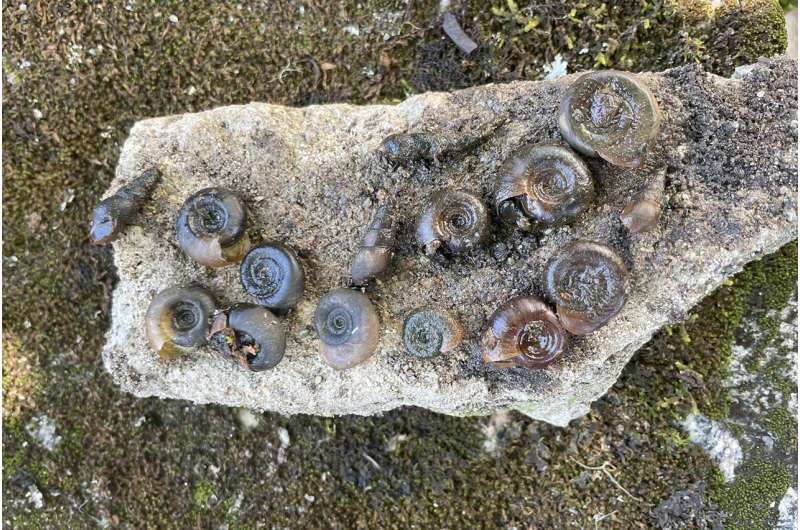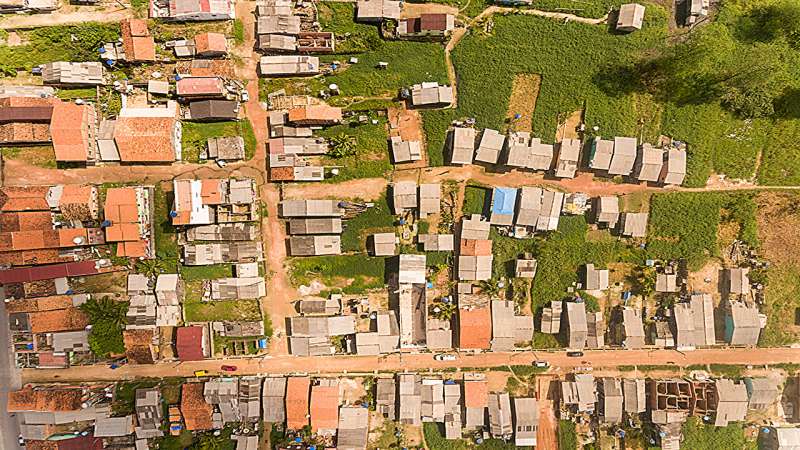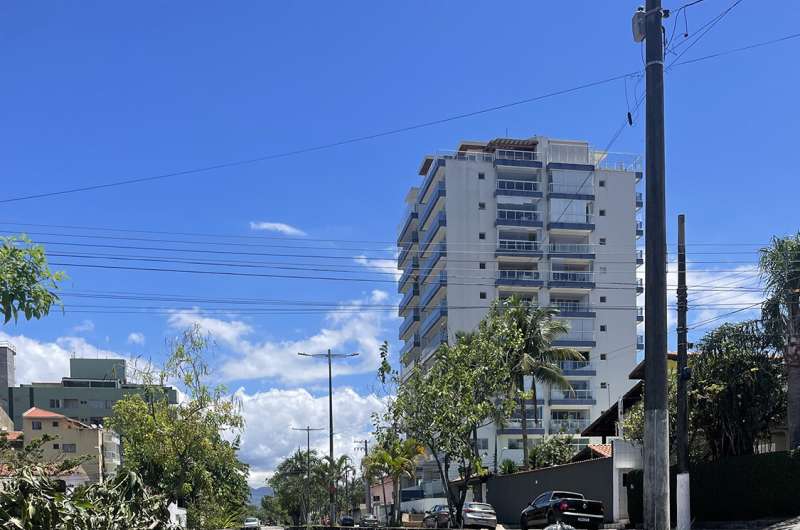This article has been reviewed according to Science X's editorial process and policies. Editors have highlighted the following attributes while ensuring the content's credibility:
fact-checked
peer-reviewed publication
trusted source
proofread
Climate change threatens progress against schistosomiasis in Brazil

In Brazil, climate and other human-made environmental changes threaten decades-long efforts to fight a widespread and debilitating parasitic disease. Now, a partnership between researchers from Stanford and Brazil is helping to proactively predict these impacts.
Schistosomiasis, spread by freshwater snails, affects more than 200 million people in many tropical regions of the world. It can cause stomach pain and irreversible consequences such as enlarged liver and cancer. Public health officials worry that deforestation, rapid urban sprawl, and changing rainfall patterns—such as Brazil's devastating May floods—could dramatically shift the locations where the snails, and therefore the parasite, can thrive.
"With climate change, more frequent and intense rains will impact many diseases here, including schistosomiasis," said Roseli Tuan, a senior researcher at the São Paulo Secretariat of Health, where she has conducted schistosomiasis surveillance and research in the state of São Paulo, Brazil, for more than 30 years. "Understanding these changes is a necessary area of science for the control of the disease in the future."
Tuan and her Brazilian colleagues have been partnering with Stanford disease ecology researchers to develop models that can predict how the disease risk will shift in response to environmental changes. Their findings were recently published in Nature Communications and PLOS Global Public Health.
"For the first time, we have been able to combine tools like long-term snail surveillance records with satellite imagery that tracks agricultural expansion, the growth of urban areas, and climate at fine resolution across entire countries," said Erin Mordecai, an associate professor of biology in the School of Humanities and Sciences and a global health faculty fellow in the Stanford Center for Innovation in Global Health.
"With these tools, we can map how the habitat for schistosomiasis-transmitting snails is changing across Brazil with unprecedented precision that helps us understand where schistosomiasis could appear next."
Mordecai co-supervised the work with Giulio DeLeo, who is also a global health faculty fellow and a professor of oceans and of Earth system science in the Stanford Doerr School of Sustainability.
The collaboration has helped epidemiologists and researchers update their paradigms about schistosomiasis in Brazil and prioritize public health interventions considering environmental changes, said Tuan, who has studied the genetics and evolution of the snail vector for schistosomiasis for four decades.
While Brazil has the chance to eliminate schistosomiasis in some parts of the country thanks to improved sanitation and living conditions, climate change and economic disparities threaten progress in other areas, she said.
"These analyses have clearly identified, for the first time, rapidly growing informal settlements both in rural areas or at the outskirts of urban centers as the most likely habitat for the snails as well as potential transmission hotspots for schistosomiasis," said De Leo, who is also the principal investigator of the international team supported by the Belmont Collaborative Forum grant. "They open new opportunities for disease surveillance and interventions that can reduce the risk of schistosomiasis transmission."

Harnessing machine learning to predict future disease risk
In 2021, a Belmont Forum/São Paulo Research Foundation grant and Stanford Global Health Seed Grant enabled disease ecology experts from Stanford and Brazil to collaboratively build tools to predict the effects of environmental changes on the disease-spreading snails.
At the heart of this effort is a tool called species distribution modeling. It combines machine learning and remotely sensed data—such as satellite imagery and large-scale climate models—to identify all the places where a species could live, based on where it has and hasn't been found in the past. The models can then predict how changes in temperature, rainfall, and urbanization will affect the species' distributions in the future.
And yet, when Aly Singleton, a Ph.D. student in Stanford's Emmett Interdisciplinary Program in Environment and Resources, set out to build such a model for snails, she found little information to help her decide which methodology would be best.
"Despite species distribution models becoming increasingly popular tools, there are still a lot of open questions about how to best build the models," Singleton said. "I wanted to create a resource that could inform our team's efforts and also be useful to researchers using these methods around the world."
Singleton's study compared models using different machine learning methods to see which could most accurately forecast how snail species responded to changes in their environment. She used vast datasets with more than 11,000 records of snail location gathered by Brazilian scientists from 1992 to 2019.
Singleton looked at how accurately the models predicted where the snails might be given various changes in climate, hydrology, land use, and soil type. She consulted with local experts, like Roseli Tuan, Antonio Miguel Vieira Monteiro of Brazil's National Institute for Space Research in Sau Paulo, Brazil, and Roberta Lima Caldeira of Fiocruz Minas in Minas Gerais, Brazil, who used their first-hand experience to judge the resulting maps' accuracy.
Singleton said that many of the models performed similarly in terms of accuracy and precision, but they produced very different maps of snail distribution. "It was absolutely critical to have the expert knowledge of people who know the area well and have been in this field for many years to be able to comment on which model they think is better and why," she said.
Some models provided much broader estimates of which areas were favorable to the snails, while others were much more stringent and narrow in their predictions of where the snail might be. Both types of models could be useful under different circumstances, Singleton said.
For instance, in a region with more limited resources to address schistosomiasis, the more stringent model could help identify areas to prioritize—those areas where the snail was almost sure to be found. On the other hand, if a country wished to eliminate schistosomiasis, officials might opt to use the broader model that predicted all possible snail habitats.

Tracking 'a moving target'
The next step was applying Singleton's findings about effective species distribution mapping to better understand how climate and land use change impacted the distribution of snails in Brazil.
Singleton's colleague Caroline Glidden, a senior scientist in the Mordecai Lab, led this research while also a fellow with the Stanford Institute for Human-Centered Artificial Intelligence (Stanford HAI). She found that climate-induced changes—especially in precipitation patterns—have driven broad shifts in the snails' range over the last 30 years. Urbanization, meanwhile, has driven more localized changes, such as the emergence of new pockets of habitat suitable to snails in areas that experienced significant population growth.
As rainfall patterns shift and Brazil undergoes rapid land-use change, new areas are expected to become favorable to the snails, which thrive in slow-moving freshwater sources, Glidden said. These include drainage ditches and canals, such as those associated with irrigation on small-scale farms.
"The general trend is that environmental changes don't just expand snail habitat—they shift the location completely, making schistosomiasis a moving target for public health intervention and control," Glidden said. "Without these analyses, it would be very difficult to aim to eliminate schistosomiasis in Brazil."
Tuan said the research will help public health officials identify priority schistosomiasis elimination zones.
Global impact
Singleton hopes their efforts to identify effective species distribution modeling methods will help researchers beyond Brazil to predict vector-borne and environmentally-mediated disease risks.
"These tools are going to become increasingly valuable as we seek to understand how species populations might change with climate and land use change," she said. "I hope this paper can help scientists new to these methods and be the resource I was looking for at the beginning of this project."
More information: Caroline K. Glidden et al, Climate and urbanization drive changes in the habitat suitability of Schistosoma mansoni competent snails in Brazil, Nature Communications (2024). DOI: 10.1038/s41467-024-48335-9
Alyson L. Singleton et al, Species distribution modeling for disease ecology: A multi-scale case study for schistosomiasis host snails in Brazil, PLOS Global Public Health (2024). DOI: 10.1371/journal.pgph.0002224




















